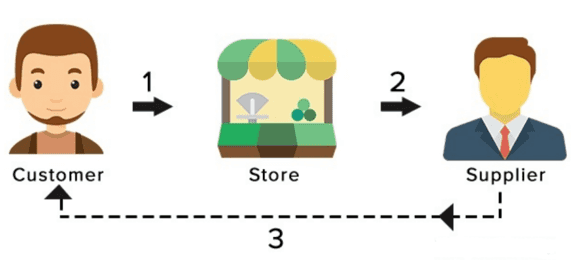Dropshipping
Dropshipping is an order fulfillment method in which a seller does not keep inventory of the items sold.
In dropshipping, the seller buys item from a third-party who will send the products directly to the buyer.
The biggest difference between dropshipping and the standard retail model is that sellers don't have inventory. Instead, sellers purchase inventory from a third party (usually a wholesaler or manufacturer) to fulfill orders.

Advantages of Dropshipping
- Less start-up capital
The biggest advantage of dropshipping is that dropshipping can be done for cross-border e-commerce businesses with very little money without a large up-front inventory investment. Also, since merchants don’t need to pre-purchase inventory to sell like traditional retail businesses, there is less risk in opening a dropshipping stand-alone site. Hence, more resources can be allocated for marketing purposes.
- Easy to use
Running an e-commerce business is easier when we don't have to deal with physical products. With dropshipping, you don't have to worry about these:
* Manage or pay warehouse fees
* Packaging and shipping order
* Track inventory
* Process returns and inbound shipments
* Ongoing ordering of products and managing stock levels
- Less overhead costs
Since independent sellers don't have to deal with purchasing inventory or managing warehouses, our overhead is very low. In fact, many successful dropshipping stores are run from home, requiring only a laptop and some basic operating expenses to operate. These costs may increase as your website grows but are still relatively low compared to a traditional brick-and-mortar business.
- Wide range of products available for sale
By not having to pre-order the products we sell, we can offer potential customers a range of popular products. As long as the supplier has the goods in stock, we can sell these goods in the independent station without adding too much cost.
- Easier to test
Dropshipping is an effective way to do this for newly established standalone sites and for merchants looking to test customer sentiment in other product categories, such as accessories or a new line of products.
- Good for business expansion
In traditional retail, if a sudden increase in orders is received, the workload usually doubles. With the dropshipping model, after the supplier bears the pressure of the goods, we can devote more energy to the operation and promotion of the website and the subsequent maintenance of customer relationships.
Disadvantages of Dropshipping
- Low profit margins
- Inventory problem
- Complexities of transportation
- Supplier error
- Limited customization and branding
Dropshipping Process
- The customer places an order and pays, and both the seller and the buyer receive the order confirmation.
- The seller sends the order information to the supplier, and they will charge the wholesale price of the product.
- The supplier (or consigner), processes the order and sends the goods to the customer.
- The forwarder will provide the seller with the invoice and logistics tracking number, and the seller will forward it to the customer.
Dropshipping Return Process
- The customer contacts the seller and requests a return.
- The seller asks the supplier to provide the RMA (Return Material Authorization) code.
- The customer returns the product to the supplier, and the address bar is marked with the RMA code.
- The retailer returns the payment for the wholesale product to the seller.
- The seller gives the customer a full refund.
Timeliness: Timeliness depends on the actual distance from the place of origin to the destination and the mode of transportation.
In NexPCB, the dropshipping we are currently in contact with is generally carried out by international expresses, such as DHL, FedEx, or UPS. For air freight, the time needed to ship is generally 5 to 8 working days
